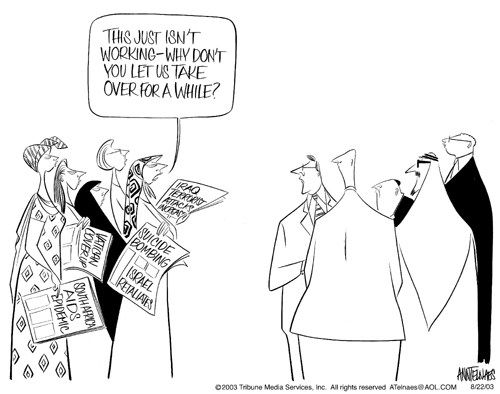Why Do Women Cross Borders?
Curator Masum Momaya Introduces “Organizing"
More than a century ago, women spent months traveling by ship to attend the first international congress on women's rights in Paris in 1878. Without the benefit of airplanes and Internet access, people's passages to and from international conventions were much more laborious and time-consuming; technological developments have made a world of difference. Nowadays, women cross borders of language, nation, gender, generation and genre more easily in their efforts to create a better world for themselves and their communities. In fact, this border has become commonplace. But why?
More than 130 years ago, women from around the world traveled to meet and talk about equal pay for equal work, government subsidies for families, the politics of housework and the double moral standard that exists for men and women. Sound familiar? In coming together, women shared stories of their local contexts and exchanged strategies for how to make change. This started a precedent that continues today, in full force.
The last 50 years have seen rapid and robust evidence of women organizing on behalf of themselves -- and getting results. Beginning in the 1970s, the U.N. World Conferences on Women were the meeting spaces for these efforts, where delegates presented reports on the status of women in their countries and shared strategies to end discrimination.
The 1975 conference in Mexico City gave birth to CEDAW, the Convention on the Elimination on All Forms of Discrimination Against Women, an international convention adopted in 1979 by the United Nations' general assembly. Most countries have ratified CEDAW, with the exception of Iran, Qatar, Somalia, Sudan, and the United States.
In the 1980s, women's organizations and movements began using CEDAW to hold their governments accountable for complicity in discrimination. However, some women's activists argued that the document and its principles are Western and don't allow for cultural rights; this tension continues today.
Twenty years after the Mexico City conference, in 1995, activists and country representatives gathered in Beijing. There, delegates drafted the Platform for Action, which addressed in a comprehensive and systematic way women's human rights, poverty, decision-making, the girl-child, reproductive rights and violence against women. This was one of the first meetings to have extensive media coverage. Now, media technologies like the internet facilitate organizing in more efficient and lucid ways.
Catalyzed by conversations in Beijing, the 1990s saw the emergence of a transnational, cross-cultural movement of advocacy groups under the banner of violence against women (VAW). The naming of VAW as a global phenomenon gave language, strength in numbers and a crystallizing frame to what were once seen as isolated, culturally specific experiences. Activist literally and conceptually transcended the borders of nations to name the phenomenon as criminal rather than cultural, and their collective global strength proved effective in local contexts.
Since 1995, the locus for international women's organizing has shifted away from the United Nations, although the UN Commission on the Status of Women holds meetings annually in New York. In these meetings, civil society organizations present country-specific reports on the status of various issues and plans for further implementation.
Women's organizations have become divided about whether this process is useful, especially given that some of them believe that power at the UN has been concentrated in the hands of a few countries and co-opted by these countries. More recently, AWID, the Association for Women's Rights in Development has been organizing International Forums every three years to bring together organizations that identify as feminist.
Today, shows of solidarity and collective strength continue to be as palpable as they were 100 years ago, with the need to cross borders - and women's competency in doing so -- ever increasing.


